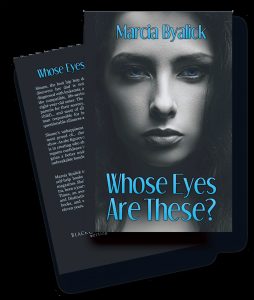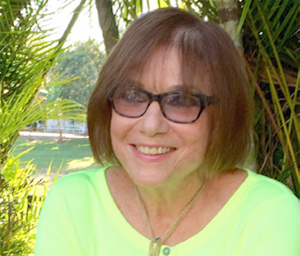“Slay a dragon everyday” is the inspirational quote that is displayed above Marcia Byalick’s computer. The author, who discovered her love for the written word later in life, has never shied away from a challenge. So years ago, when 44 new homes were being built a few feet from her own backyard, it was a determination to get her voice heard that led Byalick on the path to writing.
“The first piece I ever wrote, I sent in to the New York Times opinion page,” said Byalick, who grew up in Brooklyn and then moved to Albertson. “They were building houses behind me and all I heard was noise and trees getting cut down. The passion that I felt invigorated me to write a piece and they took it. That was the first thing I ever submitted.”
Deciding to see how far the nuance of writing could take her, Byalick wrote another piece about marriage, which the Times also published.
“After they took my second piece, I said to myself, ‘I should totally be a writer.’ Then came years and years and dozens of rejections,” said Byalick, who added that she still has a drawer filled to the brim with every rejection she has ever received. “I keep them and remember. They felt like scars and unless you have them, you just don’t get better.”
Byalick admitted that while at Brooklyn College she never took a writing class. She was completely turned off to writing thanks to her red-pen loving grammar fanatic of a fifth grade teacher.
“She destroyed everything I wrote. It completely dispirited me to the point where I never wanted to take a writing class,” said Byalick, who taught elementary school for three years and then became a biofeedback therapist. “After I had kids, I went back to school just to investigate whether I really had any talent or not and I found that I loved it. I’m paraphrasing Gloria Steinem, but when I wrote, I couldn’t do anything else,” added Byalick of the redemptive feeling of having someone tell her that her writing was good.
Byalick landed an editor’s position at The Women’s Record, which was the first Long Island monthly newspaper dedicated to women. She stayed there for seven years before taking her skills to Newsday for another 10 years. In the past 20 years she has also written several books and now teaches others to write. Yet Byalick shared the hardship that came with the publishing process and the one phrase that always kept her going.
“Tenacity over talent any day is what I tell every writing class I teach,” she said. “It’s not the most talented person in the room that I would bet my money on; it’s the person who’s the hungriest, the person who won’t give up and the person who wants it more.”

Byalick’s first book was rejected, but that didn’t stop her from writing three more, all of which went unpublished. Her sixth and most recent book, Whose Eyes Are These? took 15 years to write and many years to get published.
“The success of going further really pushed me. If I had 25 rejections and stopped there, what would have happened to number 26?” said Byalick, who would receive a rejection and have another manuscript in an envelope ready to be mailed.
Whose Eyes Are These? began with a newspaper article about a mix up with sperm. Byalick was fascinated with the topic and wanted to further explore it.
“You can tell an adopted child ‘You came from my heart, not from my belly,’ but you can’t explain to a child about sperm and eggs. If you wait until they understand the concept, you don’t want to tell them, because how can you look at them and say I’m not your biological father?” said Byalick, who added that about 86 percent of the time, it goes without mention.
“There are tens of thousands of young people today that were created this way that don’t know it.”
The book tells the story of Sloane, a hip-hop dancer in middle school who discovers that her dad is not her biological father after he is diagnosed with leukemia. When doctors turn to her 8-year-old sister Emma for a compatible bone-marrow transplant, Sloane is sent into a downward spiral of anger, jealousy and an intense curiosity about the mystery man responsible for her blue eyes. As the story progresses, Sloane gains a better understanding of forgiveness, loyalty and the unbreakable bonds of love.
“To me there is no such thing as a happy 12-year-old girl. Adolescence has been horrendously difficult since time began and it’s difficult to open up and be honest when we experience things for the first time,” said Byalick, who has always been intrigued by this time of hardship in life. “My job is to soothe the anxiety for that age group.”
For Byalick, the silver lining about waiting so many years to have this book published was that in today’s world, families are made 100 different ways. The number one rule in writing is to “write what you know” and Byalick knows the landscape of the ever-changing American family.
“I want people to take away from this that unconditional love is what makes you who you are and that your family is your family,” said Byalick, who intended for the book to be a young adult novel but was told to change it to middle grade. “The vocabulary is middle grade, but the topic is sophisticated, which is part of the reason why it was difficult to get published, along with not many people possessing the knowledge about the topic itself.”
Byalick loves getting people passionate about writing because she believes that everybody’s story is worth telling, which is a message she will share at her upcoming book chat for Whose Eyes Are These? on April 2 at 7 p.m. at the Book Revue, located at 313 New York Ave. in Huntington.
“The one thing that inspires people is leaving a legacy and telling a story,” said Byalick, who is currently teaching memoir writing to seniors. “Writing is very solitary and very isolating. The bad side is you get a little antisocial, so standing up and reading to an audience is flattering and terrifying for me.”
Aside from believing in yourself and having a tough skin, Byalick said that writing is more of a calling than a career.
“You have to feel it like a religion because there are so many negatives,” she said. “So many people say ‘no’ to you. There are so many hardships and sacrifices that you have to make and if you have that inside you, your turn will come.”



















